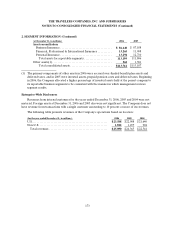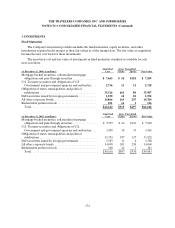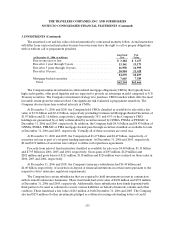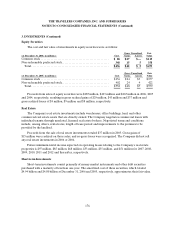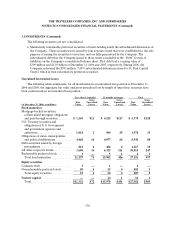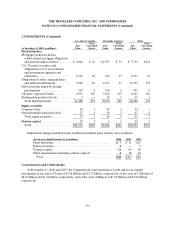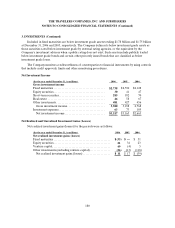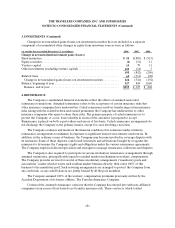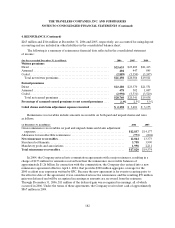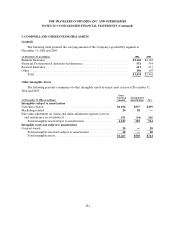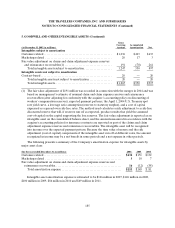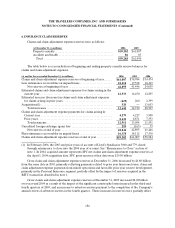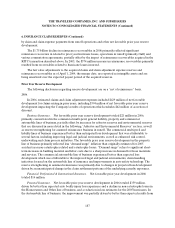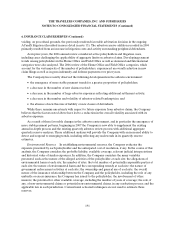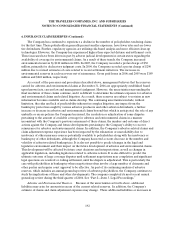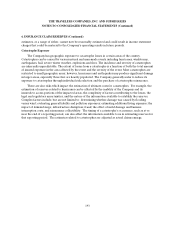Travelers 2006 Annual Report Download - page 195
Download and view the complete annual report
Please find page 195 of the 2006 Travelers annual report below. You can navigate through the pages in the report by either clicking on the pages listed below, or by using the keyword search tool below to find specific information within the annual report.THE TRAVELERS COMPANIES, INC. AND SUBSIDIARIES
NOTES TO CONSOLIDATED FINANCIAL STATEMENTS (Continued)
183
4. REINSURANCE (Continued)
Terrorism Risk Insurance Act of 2002 and Terrorism RiskInsurance Extension Act of 2005
On November 26, 2002, the Terrorism Risk Insurance Act of 2002 (the Terrorism Act) was enacted
into Federal law and established the Terrorism Risk Insurance Program (the Program), a temporary
Federal program in theDepartment of the Treasury, that provided for a system of shared public and
private compensation for insured losses resulting from acts of terrorism or war committed by or on behalf
of a foreign interest. The Program was scheduledto terminate on December 31, 2005. In December 2005,
the Terrorism Risk Insurance Extension Act of 2005 (the Terrorism Extension Act) was enacted into
Federal law, reauthorizing the Program through December 31, 2007, while reducing the Federal role under
the Program.
In order for a loss to be covered under the Program (subject losses), theloss must meet certain
aggregate industry loss minimums that vary by Program year of amounts $100 million or less, and must be
the result of an event that is certified as an act of terrorism by the U.S. Secretary of the Treasury. The
original Program excluded from participation certain of the following types of insurance: Federal crop
insurance, private mortgage insurance, financial guaranty insurance, medical malpractice insurance, health
or life insurance, flood insurance, and reinsurance. The Terrorism Extension Act exempted from coverage
certain additional types of insurance, including commercial automobile, professional liability (other than
directors and officers’), surety, burglary and theft, and farm-owners multi-peril. In the case of a war
declared by Congress, only workers’ compensation losses are covered by the Terrorism Act and the
Terrorism Extension Act. Both Acts generally require that all commercial property casualty insurers
licensed in the United States participate in the Program. Under the Program, a participating insurer is
entitled to be reimbursed by the Federal Government for a percentage of subject losses, after an insurer
deductible, subject to an annual cap. The Federal reimbursement percentage is 85% in 2007.
The deductible is calculated by applying thedeductible percentage to the insurer’s direct earned
premiums forcovered lines from the calendar year immediately preceding the applicable year. The
deductible under the Program was 10% for 2004, 15% for 2005, 17.5% for 2006 and will be 20% for 2007.
The Company’s estimated deductible under the Program is$2.20 billion for 2007. The annual cap limits
the amount of aggregate subject losses for all participating insurers to $100 billion. Once subject losses
have reached the $100 billion aggregate during a program year, Congress shall determine the source of
funds, if any, available for losses that exceedthe $100 billion cap. The Company had no terrorism-related
losses in 2006, 2005 or 2004. If the Program is not renewed for periods after January 1, 2008, the benefits
of the Program will not be available to the Company, and the Company will be subject to losses from acts
of terrorism subject only to the terms and provisions of applicable policies, including policies written in
2007 for which the period of coverage extends into 2008. Given the unpredictable frequency andseverity of
terrorism losses, as well as the limited terrorism coverage in the Company’s own reinsurance program,
future losses from acts of terrorism, particularly those involving nuclear, biological, chemical or
radiological events, could be material to the Company’s operating results, financial condition and/or
liquidity in future periods, particularly if the Program is not extended. Regardless of whether the
Terrorism Act is extended, the Company will continue to manage this type of catastrophic risk by
monitoring and controlling terrorism risk aggregations to the best of its ability.


